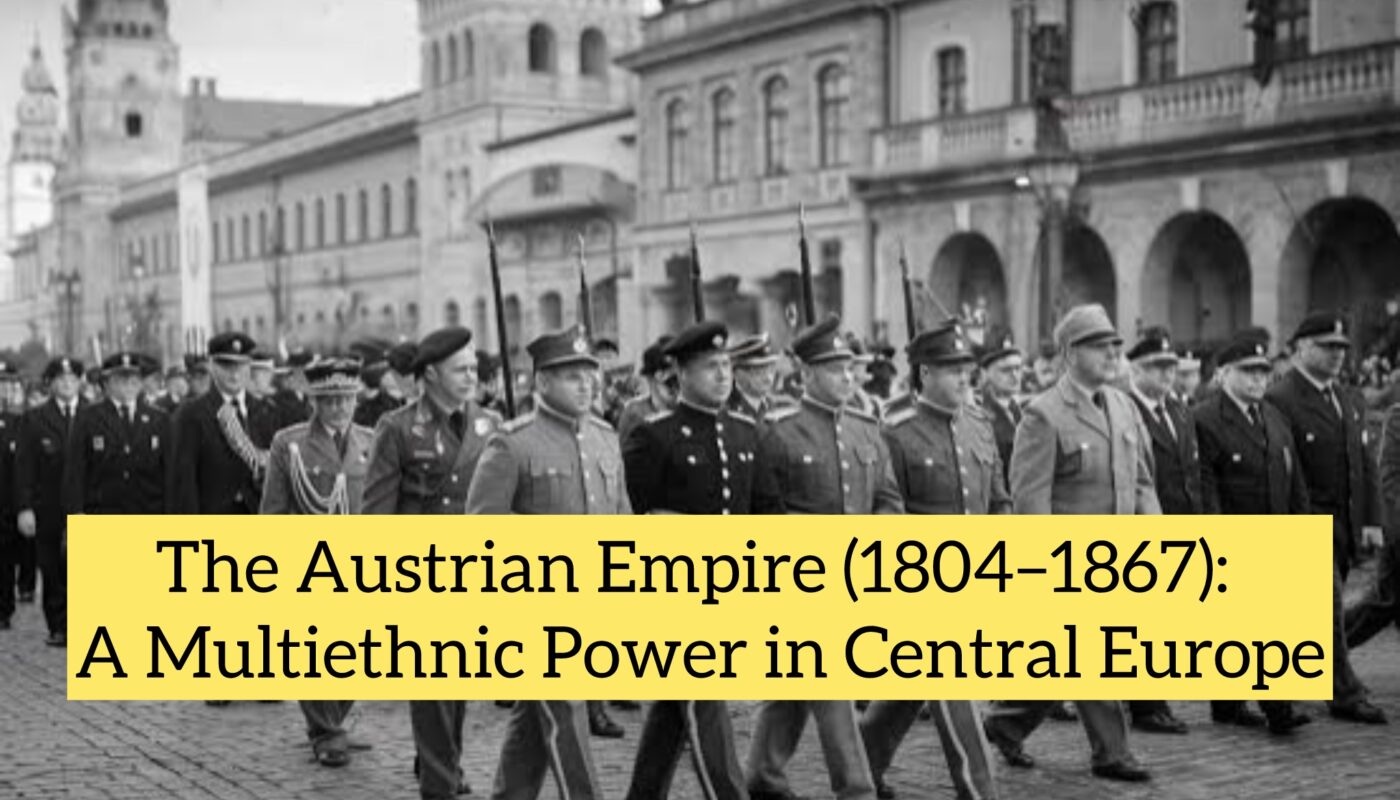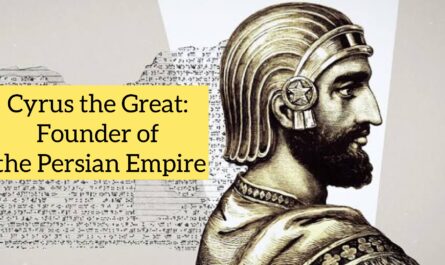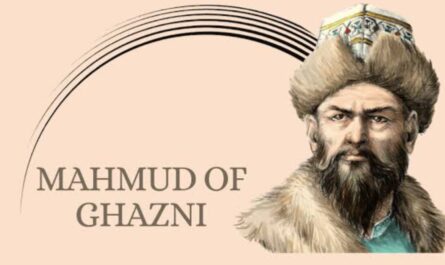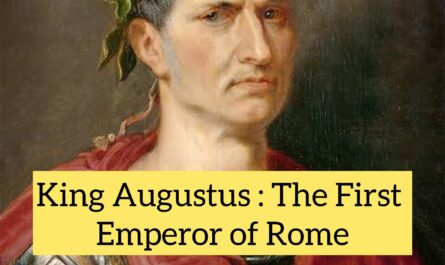Introduction
The Austrian Empire (German: Kaisertum Österreich) was a major European power that existed from 1804 to 1867. Formed during a time of significant geopolitical upheaval, it replaced the Holy Roman Empire and served as a powerful monarchy in Central Europe. Ruled by the House of Habsburg, the empire was a complex, multiethnic state encompassing a vast array of peoples, languages, and cultures. Though it experienced military defeats and internal strife, it played a key role in shaping 19th-century European politics, diplomacy, and nationalism.
Origins of the Austrian Empire
Collapse of the Holy Roman Empire
The Holy Roman Empire, which had existed for over 800 years, was a decentralized political entity centered in Central Europe and dominated by the Habsburg dynasty. In the early 19th century, it was weakened by Napoleon Bonaparte’s military campaigns and political restructuring of Europe.
In response to Napoleon declaring himself Emperor of the French in 1804, Francis II, the Holy Roman Emperor, declared himself Emperor of Austria as Francis I of Austria (Franz I) on August 11, 1804. This act created the Austrian Empire as a unified state within Habsburg-controlled territories.
In 1806, following Napoleon’s victory at Austerlitz and the formation of the Confederation of the Rhine, Francis formally dissolved the Holy Roman Empire, ending centuries of medieval political tradition.
Structure and Governance
Habsburg Monarchy
The Austrian Empire was an absolute monarchy under the House of Habsburg-Lorraine, with the emperor holding supreme authority. Despite the appearance of centralization, the empire remained highly fragmented in practice.
Administrative Divisions
The empire included a variety of lands and peoples, such as:
-
Austria proper
-
Hungary
-
Bohemia and Moravia (Czech lands)
-
Galicia and Lodomeria (parts of modern Poland and Ukraine)
-
Lombardy–Venetia (northern Italy)
-
Slovenia, Croatia, Transylvania, and others
Each region had its own historical institutions, languages, and laws, making uniform governance extremely difficult.
Languages and Ethnic Groups
The empire was multiethnic, home to Germans, Hungarians, Czechs, Slovaks, Poles, Ruthenians (Ukrainians), Croats, Serbs, Romanians, Italians, and others.
This ethnic diversity led to national tensions, as various groups sought autonomy or independence in the 19th century.
Key Periods and Events
Napoleonic Wars (1804–1815)
Austria was a key opponent of Napoleon, participating in multiple coalitions against France. Despite several military defeats (notably at Austerlitz in 1805 and Wagram in 1809), Austria played a central role in the final victory over Napoleon in 1815.
Congress of Vienna (1814–1815)
After Napoleon’s defeat, Austria hosted and led the Congress of Vienna, which redrew the map of Europe and restored monarchies. The Austrian foreign minister, Prince Klemens von Metternich, emerged as the architect of post-Napoleonic Europe.
Metternich promoted conservatism, monarchy, and balance of power, ushering in the Concert of Europe, a period of relative peace and diplomatic cooperation among European powers.
The Metternich Era (1815–1848)
This was a period of political repression and censorship:
-
Suppression of liberal and nationalist movements.
-
Secret police and surveillance of dissidents.
-
Resistance to constitutional reforms.
However, the Industrial Revolution began to take root, especially in Bohemia and Austria, bringing economic and social changes.
Revolutions of 1848
A wave of revolutions swept across Europe in 1848, and the Austrian Empire was deeply affected:
-
In Vienna, students and workers demanded a constitution and civil liberties.
-
In Hungary, led by Lajos Kossuth, a nationalist uprising sought autonomy and reforms.
-
In Italy, uprisings in Lombardy–Venetia sought independence.
The revolutions temporarily forced Metternich to resign and flee the country. However, with military force and Russian support, the Habsburgs crushed the revolts by 1849 and reasserted control.
Neo-Absolutism (1849–1860)
After 1848, Emperor Franz Joseph I, who came to the throne in 1848, instituted centralized rule, abolishing constitutional governance. This period saw:
-
Increased state control.
-
Suppression of national and liberal movements.
-
Investment in railways and infrastructure.
Despite repression, demands for reform continued to grow.
Foreign Policy and Conflicts
Austro-Prussian Rivalry
Austria and Prussia vied for dominance in German affairs. This competition culminated in:
-
Austro-Prussian War (1866), also known as the Seven Weeks’ War.
-
Austria was defeated at the Battle of Königgrätz.
-
Resulted in Austria being excluded from German unification, which Prussia led.
Loss of Italian Territories
During the Second Italian War of Independence (1859), Austria lost Lombardy to France and the Kingdom of Sardinia. By the 1860s, much of northern Italy had unified, further shrinking Austria’s influence.
The Austro-Hungarian Compromise (Ausgleich) of 1867
Ethnic tensions, especially in Hungary, forced the Habsburg monarchy to reconsider its structure. In 1867, Austria and Hungary agreed to form the Austro-Hungarian Empire, a dual monarchy where:
-
Austria and Hungary were equal partners.
-
Each had its own parliament and government.
-
They shared a common monarch (Franz Joseph I), military, and foreign policy.
This marked the end of the Austrian Empire and the beginning of the Austro-Hungarian Empire.
Cultural and Scientific Achievements
Despite political struggles, the Austrian Empire was a cultural powerhouse:
-
Vienna became a center for classical music, with composers like Franz Schubert and Johann Strauss.
-
The empire fostered scientific and intellectual developments in fields like medicine, philosophy, and engineering.
-
Prominent figures like Gregor Mendel (father of genetics) and Sigmund Freud (in the later period) had ties to the empire.
Legacy of the Austrian Empire
Strengths:
-
Maintained stability in Central Europe for decades.
-
Preserved a multiethnic empire for over 60 years.
-
Cultural and intellectual contributions were significant.
Weaknesses:
-
Inability to reconcile nationalistic aspirations with imperial control.
-
Resistance to democratic reform.
-
Military defeats and territorial losses undermined prestige.
The legacy of the Austrian Empire can still be seen today in the architecture, legal systems, and cultural identity of many Central European nations such as Austria, Hungary, the Czech Republic, Slovakia, Slovenia, and parts of Italy, Romania, Ukraine, and the Balkans.
Conclusion
The Austrian Empire was a major force in 19th-century Europe, navigating a delicate balance between conservatism and modernization, unity and diversity. Its fall paved the way for the Austro-Hungarian Empire, which would in turn collapse after World War I, ending centuries of Habsburg rule. Yet, the political, legal, and cultural foundations laid during the Austrian Empire continue to resonate in European history and identity.



